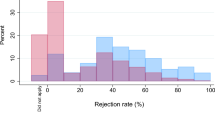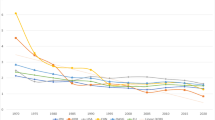Abstract
The global expansion of access to higher education has increased demand for information on academic quality and has led to the development of university ranking systems or league tables in many countries of the world. A recent UNESCO/CEPES conference on higher education indicators concluded that cross-national research on these ranking systems could make an important contribution to improving the international market for higher education. The comparison and analysis of national university ranking systems can help address a number of important policy questions. First, is there an emerging international consensus on the measurement of academic quality as reflected in these ranking systems? Second, what impact are the different ranking systems having on university and academic behavior in their respective countries? Finally, are there important public interests that are thus far not reflected in these rankings? If so, is there a needed and appropriate role for public policy in the development and distribution of university ranking systems and what might that role be? This paper explores these questions through a comparative analysis of university rankings in Australia, Canada, the UK, and the US.
Similar content being viewed by others
References
A.W. Astin (1985) Achieving Educational Excellence: A Critical Assessment of Priorities and Practices in Higher Education Jossey-Bass Publishers San Francisco, London
A.W. Astin (1991) Assessment for Excellence: The Philosophy and Practice of Assessment and Evaluation in Higher Education American Council on Education/Macmillan New York
A.W. Astin (1996) ArticleTitle‘Involvement in learning revisited’ Journal of College Student Development. 40 IssueID5 587–597
G.S. Becker (1964) Human Capital Columbia University Press New York
R. Bowden (2000) ArticleTitle‘Fantasy higher education: University and college league tables’ Quality in Higher Education. 6 IssueID1 41–60 Occurrence Handle10.1080/13538320050001063
J. Brennan T. Shah (2000) Managing Quality in Higher Education: An International Perspective on Institutional Assessment and Change OECD, SRHE & Open University Press Buckingham UK
D. Brewer S.M. Gates C.A. Goldman (2002) In Pursuit of Prestige: Strategy and Competition in US Higher Education Transaction Press New Brunswick, NJ
C.S. Carrico S.M. Hogan R.G. Dyson A.D. Athanassopoulos (1997) ArticleTitle‘Data envelope analysis and university selection’ The Journal of the Operational Research Society. 48 IssueID12 1163–1177 Occurrence Handle10.1038/sj.jors.2600475
M. Clarke (2002) ArticleTitle‘Some guidelines for academic quality rankings’ Higher Education in Europe. 27 IssueID4 443–459 Occurrence Handle10.1080/0379772022000071922
H. Connor R. Burton R. Pearson E. Pollard J. Regan (1999) Making the Right Choice: How Students Choose Universities and Colleges Universities UK London
InstitutionalAuthorNameDepartment for Education (DfES). Skills (2003) The Future of Higher Education HMSO London
D.D. Dill (1999) ‘Student learning and academic choice: The rule of coherence J. Brennan J. Fedrowitz M. Huber T. Shah (Eds) What Kind of University? International Perspectives on Knowledge, Participation and Governance. Open University Press and Society for Research into Higher Education Buckingham 56–70
D.D. Dill (2000) ArticleTitle‘Designing academic audit: Lessons learned in Europe and Asia’ Quality in Higher Education. 6 IssueID3 187–207 Occurrence Handle10.1080/13538320020005945
D.D. Dill (2003) ArticleTitle‘Allowing the market to rule: The case of the United States’ Higher Education Quarterly. 57 IssueID2 136–157 Occurrence Handle10.1111/1468-2273.00239
L.T. Drennan M. Beck (2001) ArticleTitle‘Teaching quality performance indicators – Key influences on the UK universities’ scores’ Quality Assurance in Education. 9 IssueID2 92–102
C. Eccles (2002) ArticleTitle‘The use of university rankings in the United Kingdom’ Higher Education in Europe. 27 IssueID4 423–432 Occurrence Handle10.1080/0379772022000071904
R.G. Ehrenberg (2002) ArticleTitle‘Reaching for the brass ring: The U.S. News & World Report rankings and competition’ The Review of Higher Education. 26 IssueID2 145–162
R.G. Ehrenberg (2002) Tuition Rising: Why College Costs so Much Harvard University Press Cambridge
Ehrenberg R.G. (2003). ‘Method or madness?: Inside the USNWR college rankings’, Paper presented at the Wisconsin Center for the Advancement of Postsecondary Education Forum on The Abuse of College Rankings, Madison, Wisconsin, 20–21 November
R.G. Ehrenberg P.J. Hurst (1996) ArticleTitle‘A hedonic model’ Change. 28 IssueID3 46–51
W.T. Gormley SuffixJr. D.L. Weimer (1999) Organizational Report Cards Harvard University Press Cambridge Mass
A. Graham N. Thompson (2001) ArticleTitle‘Broken ranks: US News’ college rankings measure everything but what matters And most universities don’t seem to mind’. Washington Monthly. 33 IssueID9 9–14
S.G. Grunig (1997) ArticleTitle‘Research, reputation, and resources: The effect of research activity on perceptions of undergraduate education and institutional resource acquisition’ Journal of Higher Education. 68 IssueID1 17–52
Higher Education Division, Australia (2001). Characteristics and Performance Indicators of Australian Higher Education Institutions. Occasional Paper Series 01-B, Department of Education, Science and Training: http://www.dest.gov.au/highered/statistics/characteristics/characteristics00.pdf
Higher Education Funding Council for England (HEFCE) (1999). Performance Indicators in Higher Education: First Report of the Performance Indicators Steering Group (PISG). Report 99/11, Higher Education Funding Council for England: http://www.hefce.ac.uk/pubs/hefce/1999/99%5F11.htm
Higher Education Funding Council for England (HEFCE) (2003). Performance Indicators in Higher Education: 2000–2001 and 2001–2002. Report 2003/59, Higher Education Funding Council for England: http://www.hefce.ac.uk/learning/perfind/2003/default.asp
M. Henkel (2000) Academic Identities and Policy Change in Higher Education Jessica Kingsley London
D. Hossler J. Braxton G. Coopersmith (1989) ‘Understanding student college choice’ J.C. Smart (Eds) Higher Education: Handbook of Theory and Research, Vol.V. Agathon Press New York 231–288
D. Hossler L.H. Litten (1993) Mapping the Higher Education Landscape College Entrance Examination Board New York
R. James G. Baldwin C. McInnis (1999) Which University? The Factors Influencing the Choices of Prospective Undergraduates Australian Government Publishing Service Canberra
J. Koelman R. Venniker (2001) ‘Public funding of academic research: The research assessment exercise in the UK’ CPB. CHEPS (Eds) Higher Education Reform: Getting the Incentives Right. Sdu Uitgevers Den Haag The Netherlands 101–117
G. Kuh (2003) ArticleTitle‘What we’re learning about student engagement from NSSE’ Change. 35 IssueID2 24–32
Larsen K., Martin J.P., Morris R. (2002). ‘Trade in educational services: Trends and emerging issues’. Paper Presented at the OECD Forum on Trade In Educational Services, May 23–24, Washington DC
P.M. McDonough A.L. Antonio L.X. Perez (1998) ArticleTitle‘College rankings: democratized college knowledge for whom?’ Research in Higher Education. 39 IssueID5 513–537 Occurrence Handle10.1023/A:1018797521946
C.F. Manski D.A. Wise (1983) College choice in America Harvard University Press Cambridge, MA
J.P. Merisotis (2002) ArticleTitle‘Summary report of the invitational roundtable on statistical indicators for the quality assessment of higher/tertiary education institutions: Ranking and league table methodologies’ Higher Education in Europe. 27 IssueID4 475–480 Occurrence Handle10.1080/0379772022000071959
J. Monks R.G. Ehrenberg (1999) ArticleTitle‘U.S. News & World Report’s college rankings: Why they do matter’ Change. 31 IssueID6 42–51
Y.J. Moogan S. Baron K. Harris (1999) ArticleTitle‘Decision-making behaviour of potential higher education students’ Higher Education Quarterly. 53 IssueID3 211–228 Occurrence Handle10.1111/1468-2273.00127
H.G. Morrison S.P. Magennis L.J. Carey (1995) ArticleTitle‘Performance indicators and league tables: A call for standards’ Higher Education Quarterly. 49 IssueID2 128–145
InstitutionalAuthorNameNational Association of Scholars (1996) The Dissolution of General Education: 1914–1993 National Association of Scholars Princeton
National Opinion Research Center (1997). A Review of the Methodology for the US News and World Report’s Rankings of Undergraduate Colleges and Universities. Washington Monthly: http://www.washingtonmonthly.com/features/2000/norc.html
S. Page (1999) ArticleTitle‘Rankings of Canadian universities and help to students’ Guidance & Counseling. 14 IssueID3 11–14
E.T. Pascarella (2001) ArticleTitle‘Identifying excellence in undergraduate education: Are we even close?’ Change. 33 IssueID3 19–23
E.T. Pascarella P.T. Terenzini (1991) How College Affects Students: Findings and Insights from Twenty Years of Research Jossey-Bass San Francisco
E.T. Pascarella P.T. Terenzini (1998) ArticleTitle‘Studying college students in the 21st century: Meeting new challenges’ The Review of Higher Education. 21 IssueID2 151–165
Paulsen M.B. (1990). College Choice: Understanding Student Enrollment Behavior. ASHE-ERIC Higher Education Report No 6. The George Washington University, School of Education and Human Development, Washington DC
Provan, D., Abercromby, K. (2000). University League Tables and Rankings: A Critical Analysis. Commonwealth Higher Education Management Service (CHEMS) Paper No. 30: htpp://www.acu.ac.uk/chems/onlinepublications/976798333.pdf
P. Ramsden (1991) ArticleTitle‘A Performance indicator of teaching quality in higher education: The course experience questionnaire’ Studies in Higher Education. 16 IssueID2 129–149
H. Rosovsky M. Hartley (2002) Evaluation and the Academy: Are We Doing the Right Thing? American Academy of Arts and Sciences Cambridge Mass
J. Smith A. McKnight R. Naylor (2000) ArticleTitle‘Graduate employability: Policy and␣performance in higher education in the UK’ The Economic Journal. 110 IssueIDJune 382–411 Occurrence Handle10.1111/1468-0297.00546
Stecklow S. (1995). ‘Colleges inflate SAT’s and graduation rates in popular guidebooks’, Wall Street Journal 5 April
P.T. Terenzini E.T. Pascarella (1994) ArticleTitle‘Living with myths: Undergraduate education in America’ Change. 26 IssueID1 28–32
N. Thompson (2000) ArticleTitle‘Playing with numbers: How US News mismeasures higher education and what we can do about it’ Washington Monthly 32 IssueID9 16–23
M. Tight (2000) ArticleTitle‘Do league tables contribute to the development of a quality culture? Football and higher education compared’ Higher Education Quarterly. 54 IssueID1 22–42 Occurrence Handle10.1111/1468-2273.00143
Trow M. (1999). ‘Biology at Berkeley: A case study of reorganization and its costs and benefits’, Center for Studies in Higher Education: Research and Occasional Papers Series, CSHE.1.99: htpp://ibb.berkeley.edu/cshe/
M.A. Trow (1983) ArticleTitle‘Organizing the biological sciences at Berkeley’ Change. 15 IssueID8 28–4453
K. Wilson A. Lizzio P. Ramsden (1997) ArticleTitle‘The development, validation and application of the course experience questionnaire’ Studies in Higher Education. 22 IssueID1 3–25
Winston G.C., Zimmerman D.J. (2003). ‘Peer effects in higher education’, NBER Working Paper 9501: http://www.nber.org/papers/w9501
M. Yorke (1997) ArticleTitle‘A good league table guide?’ Quality Assurance in Education. 5 IssueID2 61–72 Occurrence Handle10.1108/09684889710165107
M. Yorke (1998) ArticleTitle‘The Times “League Table” of universities, 1997: A statistical appraisal’ Quality in Education. 6 IssueID1 58–60 Occurrence Handle10.1108/09684889810200403
M. Yorke G. Barnett P. Bridges P. Evanson C. Haines D. Jenkins P. Knight D. Scurry M. Stowell H. Woolf (2002) ArticleTitle‘Does grading method influence honours degree classification?’ Assessment & Evaluation in Higher Education. 27 IssueID3 269–279
R. Zemsky P. Oedel (1983) The Structure of College Choice College Entrance Examination Board New York
Author information
Authors and Affiliations
Corresponding author
Rights and permissions
About this article
Cite this article
Dill, D.D., Soo, M. Academic quality, league tables, and public policy: A cross-national analysis of university ranking systems. High Educ 49, 495–533 (2005). https://doi.org/10.1007/s10734-004-1746-8
Issue Date:
DOI: https://doi.org/10.1007/s10734-004-1746-8




